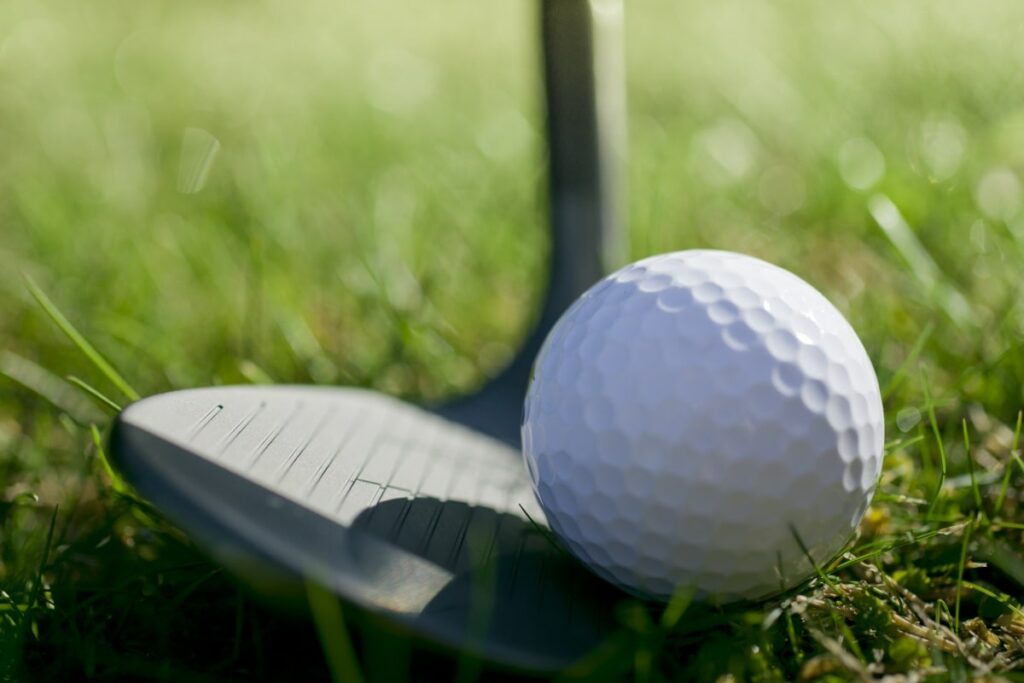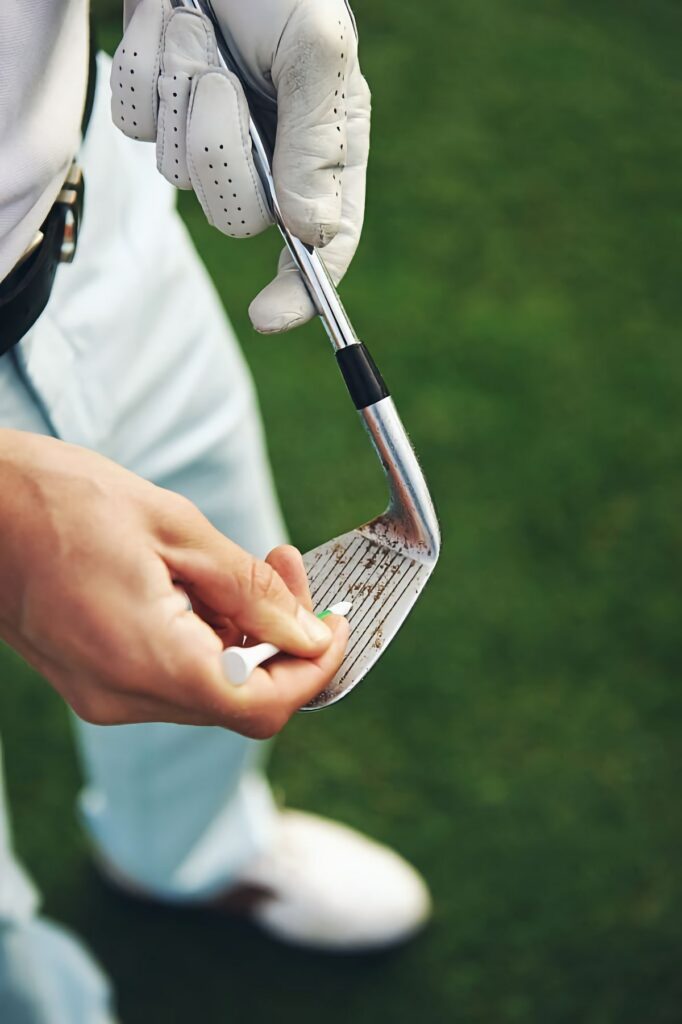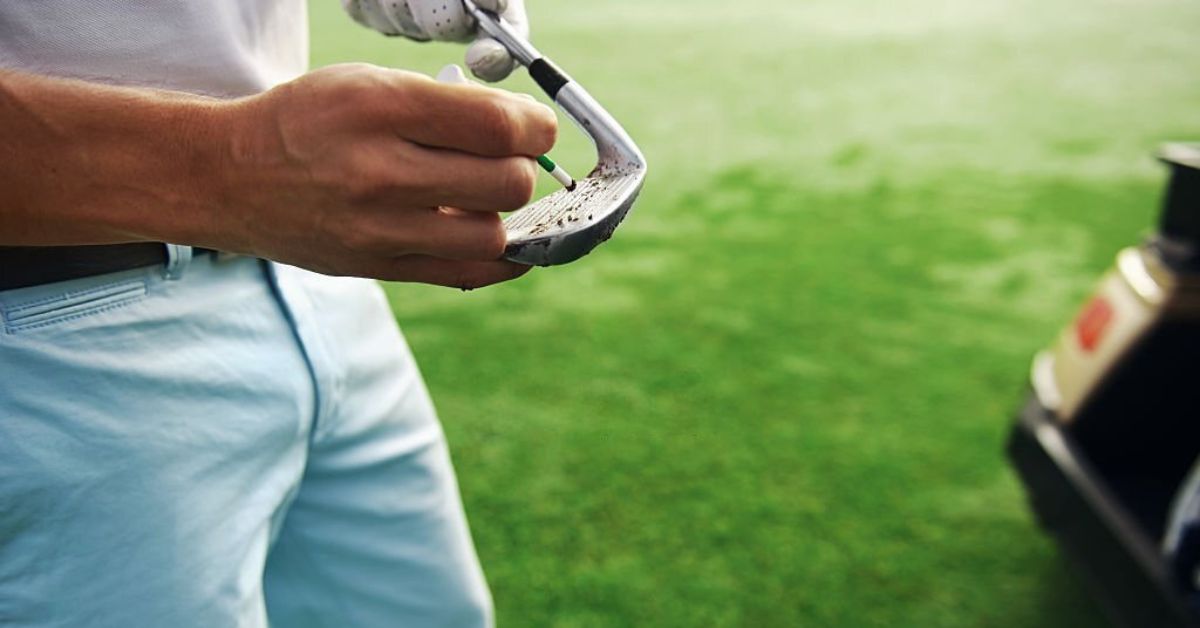Over time, your wedge grooves can become blunt as the sharp edge wears off after repeated ball strikes. This impacts the friction against the ball, and the amount of spin generated.
Sharpening your wedge grooves will add more spin to your pitch and chip shots, helping you control those all-important short approach shots into the green.
In this article, you’ll learn how to sharpen wedge grooves at home, so you can generate more spin with your wedges. Also, I’ll be discussing the USGA rules on groove sharpening, and when clubs can be deemed non-conforming.
How to Sharpen Wedge Grooves
To sharpen wedge grooves, first, remove any surface dirt by cleaning the clubface with soapy water. Then, apply electrical tape to the heel and toe to prevent scratches. Finally, add some WD40 lubricant and—using a groove sharpener tool—slide the sharp tool slowly and firmly through the grooves of the wedge.

Before You Start
You will need a few tools to sharpen your wedge grooves:
- Electrical tape
- Lubricant
- Groove sharpener tool (get yours here)
Let’s start by prepping the wedge and protecting the toe and heel of the clubface:
Step 1: Prep the Clubface
Firstly, wash the club using soapy water. This removes any surface dirt from the clubface which can impact the groove sharpening process.
Then, apply electrical tape to the toe and heel of the clubface. This protects the polished edges from being scratched, in case you slip when sharpening
Step 2: Apply the Lubricant
Next, apply lubricant to the clubface. This will enable the groove sharpener tool to glide through the grooves of the wedge.
PRO TIP: WD40 works perfectly as a general lubricant.
Step 3: Sharpen the Grooves
Finally, use the groove sharpener tool to sharpen the grooves. Press firmly and evenly when passing the sharp head of the tool across the grooves.
Be slow and deliberate when using the groove sharpener – it only takes a few strokes for the groove to become sharp enough.
The sharpness of the tool’s head will grind away a small amount of metal within each groove on the clubface, bringing the wedge back to its former glory.
PRO TIP: Check with your wedge manufacturer to find out the shape of your wedge grooves – they’re either U or V-grooved. Then, use the appropriate head shape in the groove sharpener tool.
>> You can order your Groove Sharpener Tool here
In the video below by TickTockGolf, the sharpening process is demonstrated using the same 6-head groove sharpener recommended above:
Do Groove Sharpeners Work?
The concept of sharpening the grooves on your old wedges is great! It saves you money from buying new wedges every time the wedges get worn down and enables you to keep your favorite old wedge at the top of its spin game.
But do groove sharpeners actually work?
The short answer is yes, they do!
To put the groove sharpener to the test, Matt Fisher used Trackman data to compare the spin rates of an old Vokey SM5 wedge before and after sharpening the grooves:
Having also recorded shots with a brand-new Vokey SM7 wedge, the data found that regrooving makes a significant difference to spin rates:
| Old Vokey SM5 | Regrooved Vokey SM5 | New Vokey SM7 | |
| Spin Rate (rpm) | 9072 | 9375 | 9279 |
| Carry (yards) | 101.6 | 103.8 | 104.8 |
| Ball Speed (mph) | 84.1 | 85.3 | 85.8 |
The regrooved SM5 wedge produced higher spin rates than it did previously—with worn grooves—which provided an increase in ball speed and carry distance.
In fact, the regrooved SM5 generated a higher spin rate than a brand-new SM7!
Therefore, it is clearly evident that groove sharpeners are a great way to restore the grooves on your old wedges.
But having said that, is it legal? And do regrooved wedges conform to standards? Read on to learn the USGA rules on the topic of sharpened grooves.
Is It Legal to Sharpen Grooves on Wedges?
Yes, it’s legal to sharpen wedge grooves using a groove sharpener tool. However, it’s what you do with the tool that can render a club non-conforming.
In 2010, the USGA revised its rules on golf club grooves. It stated that for clubs with lofts of 25 degrees or more (five iron and shorter), the edges of the grooves must have a radius of between 0.010 and 0.020 inches.
Essentially, this means you should be careful to not apply too much pressure when using a groove sharpener tool to restore the grooves. Pass the tool through the grooves a few times with moderate-to-firm pressure to avoid the risk of deepening the grooves too much.
However, it’s worth noting that spin rates are usually optimized with just a few strokes of the groove sharpener. Beyond a certain point, extra sharpening produces minimal results.
Of course, if you’re playing golf recreationally there’s nothing to worry about!

Conclusion
Groove sharpener tools are proven to improve performance by generating more spin, helping you control short approach shots into the green with your wedges.
To sharpen your wedge grooves at home, follow this simple 3-step process:
- Prep the clubface: Clean and apply tape to the toe and heel
- Apply the lubricant: WD40 works perfectly
- Sharpen the grooves: Using a groove sharpener
Furthermore, it’s legal to sharpen your grooves, provided that you don’t significantly over-sharpen to the point at which the groove-edge radius exceeds 0.020 inches.


